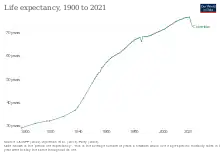Health care in Colombia
Health care in Colombia refers to the prevention, treatment, and management of illness and the preservation of mental and physical well-being through the services offered by the medical, nursing, and allied health professions in the Republic of Colombia.

The Human Rights Measurement Initiative[1] finds that Colombia is fulfilling 94.0% of what it should be fulfilling for the right to health based on its level of income.[2] When looking at the right to health with respect to children, Colombia achieves 96.3% of what is expected based on its current income.[3] In regards to the right to health amongst the adult population, the country achieves only 91.7% of what is expected based on the nation's level of income.[3] Colombia falls into the "fair" category when evaluating the right to reproductive health because the nation is fulfilling 93.9% of what the nation is expected to achieve based on the resources (income) it has available.[3]
Health issues
Tropical diseases are important issues in Colombia because they are major causes of death. Malaria affects nearly 85% of the national territory, mainly the Pacific ocean coast, the Amazon jungle and eastern savannas, with an estimated of 250,000 cases/year and a mortality rate of 3/100,000.[4] The main agent is Plasmodium vivax with 66% of the cases, except on the Pacific coast, where Plasmodium falciparum causes 75% of the cases.
Yellow fever and Dengue fever[5] are major public health concerns, because of their high epidemic potential, high mortality rate and wide distribution of Aedes aegypti. The Colombian government develops vaccination campaigns against yellow fever on a regular basis.[6]

Chagas disease is endemic to the Santander Department and nearby areas. Other diseases such as Leishmania, rabies, Venezuelan equine encephalitis virus and West nile virus are also present in Colombia.[4] Snakebites are a big concern, because of the shortage in antivenom supplies countrywide.[7]
Different forms of malnutrition severely affect the population, especially children under five years of age, with moderate to severe rates of malnutrition of 21% and iron deficiency anemia of 23%.[8] (see aguapanela).
History
In 1514, a swine plague killed a majority of the thousand inhabitants of Darién in modern-day Urabá. In 1550, Cartagena suffered an epidemic of leprosy, which they called "elefancia".[9]
The first graduated medical doctor, Alvaro de Aunón came to New Granada from Seville Spain, in 1597 and stayed for a short time. The first drug-store in Colombia was opened at the same time, in the main square of Bogotá by Pedro Lopez Buiza.[10]

In 1636, Rodrigo Enriquez de Andrade started the first faculty of medicine in the New Granada, at St Bartholomew's College with little success because of the prejudices against the medical career in the Spanish culture, where it was considered vulgar and proper of lower-class people. Most of the medical practice in the country was provided by people without formal education.[11] The first medical book written in Colombia was "Tratado de medicina y modelo de curar en estas partes de Indias" (English: Treatise on Medice and Models for Curing in These Parts of the Indies) by Pedro Fernandez de Valenzuela (1662).
In 1740, don Vicente Tomás Cansino started the medical program at Our Lady of the Rosary University. The medical care at the time was made almost exclusively in the particular homes of the sick people due lo the lack of health institutions. The first hospital in Colombia was San Pedro Hospital, in the capital city Bogotá. The hospital started functioning in 1564, built by bishop Juan de los Barrios. In 1739 the Hospital San Juan de Dios, Bogota was opened,[12] built by fray Pedro Pablo Villamor.
In 1877, Anna Galvis Hotz became the first Colombian woman to become a Doctor of Medicine having graduated the University of Bern in Switzerland since women could not attend university in Colombia at the time. In 1925, Paulina Beregoff became the first woman to become a Doctor of Medicine from a Colombian institution, the Russian-American graduated from the University of Cartagena. In 1945, Inés Ochoa Pérez became the first Colombian woman to become a Doctor of Medicine from a Colombian institution having graduated from the National University of Colombia.
Health standards in Colombia have improved greatly since the 1980s. A 1993 reform transformed the structure of public health care funding by shifting the burden of subsidy from providers to users. As a result, employees have been obligated to pay into health plans to which employers also contribute. Although this new system has widened population coverage by the social and health security system from 21% (pre-1993) to 56% in 2004 and 66% in 2005, health disparities persist, with the poor continuing to suffer relatively high mortality rates.
The refractive surgery keratomileusis was developed by Ignacio Barraquer in 1964 in Bogotá. On January 10, 1985, Dr. Elkin Lucena performed the first successful In vitro fertilization, that allowed the birth of the first Latin American test tube baby Carolina Mendez. On December 14, 1985, the Dr. Alberto Villegas performed the first heart transplant in Latin America to Antonio Yepes.[13]
On May 20, 1994, Dr. Manuel Elkin Patarroyo received the Prince of Asturias Awards by his technical and scientific research in the development of synthetic malaria vaccine.
In 2002 Colombia had 58,761 physicians, 23,950 nurses, and 33,951 dentists; these numbers equated to 1.35 physicians, 0.55 nurses, and 0.78 dentists per 1,000 people, respectively. In 2005 Colombia was reported to have only 1.1 physicians per 1,000 people, as compared with a Latin American average of 1.5.
Status of public health

General government spending on health accounted for 20.5% of total government expenditures and for 84.1% of total health expenditures (private expenditures made up the balance) in 2003. Total expenditures on health constituted 5.6 percent of domestic product in 2005. The per capita expenditure on health care in 2005 at an average exchange rate was US$150.[14]
Urban and rural residents experienced significant differences in access to health care. The coverage in the three largest cities—Bogotá, Medellín, and Cali—was almost 95 percent. At the rural level, the best services were delivered by the departments in the coffee-growing areas. At the bottom of the scale—in terms of quality and coverage—were the rural areas in the non-Andean regions as well as the marginal neighborhoods in medium-sized and small cities.
Since 2001–2 Colombia has halved its homicide rate, which was more than 60 per 100,000 inhabitants, or 28,837, in 2002, one of the world's highest homicide rates. In 2006, a total of 17,206 violent deaths were recorded, the lowest figure since 1987. Other than homicide, heart disease is the main cause of premature death, followed by strokes, respiratory diseases, road accidents, and diabetes. Waterborne diseases such as cerebral malaria and leishmaniasis are prevalent in lowland and coastal areas. Child immunization for measles in 2004 as a percentage of children under 12 months of age was 92 percent.[14]
Acquired immune deficiency syndrome (AIDS) is the fifth-leading cause of death in the working-age population. According to Colombia's National Health Institute data reported in 2003, nearly 240,000 people—mostly women and young people—or 0.6 percent of the population had been infected with the virus since AIDS arrived in Colombia in October 1983. Estimates of the number of people living with human immunodeficiency virus (HIV), adults and children (0–49 years of age), in 2005 ranged from 160,000 to 310,000. The comparable figure for women (15–49 years of age) was 62,000. The number of AIDS and hepatitis B cases has been rising. In 2005, the estimated HIV adult prevalence rate (15–49 years of age) was 0.6 percent. As of 2006, between 5,200 and 12,000 people had died from AIDS. Services provided by the new Multisectoral National Plan, launched in July 2004, include integrated care for people living with HIV and provision of antiretroviral drugs. Under the plan, about 12,000 people have been receiving combined antiretroviral therapy (approximately 54% of those requiring it).[14]
Vaccination
As of 2016, Colombia vaccinated against 26 diseases and participated in Vaccination Week in the Americas.[15] Colombia began vaccinating against COVID-19 in February 2021.[16]
Law 100 of 1991
The national constitution was reformed in 1991 and with this purpose the general system of social security was reformed with the implementation of Law 100, which widely extended health coverage to the population; the economic resources to finance this reform, however, were insufficient, causing the collapse of many public health institutions and affecting the income of the medical staff.[17] The law 100 of 1993 is divided into four books:
- First book: About Pension regulations.
- Second book: About the general system of healthcare
- Third book: About Occupational safety and health
- Fourth book: About Complementary social services
The reform of the Colombian healthcare had three main goals:
- The achievement of an antitrust policy, to avoid the statal health monopoly.
- The incorporation of private health providers into the healthcare market
- The creation of a subsidiated healthcare sector covering the poorest population.
The general principles of the law determine that healthcare is a public service that must be granted under conditions of proficiency, universality, social solidarity and participation. Article 153 of the law mandates that health insurance be compulsory, that health providers must have administrative autonomy, and that health users must have free choice of health providers.
Glossary of Acronyms
- SISBEN: Sistema de Identificación de Beneficiarios de Subsidios Sociales (system of identification for social subsidies beneficiaries).
- EPS: Entidades Promotoras de Salud. (Health promoting entities)
- EPS-S: Entidades Promotoras de Salud Subsidiadas. (Subsidized Health promoting entities).
- INS: Instituto Nacional de Salud (National Institute of Health)
- IPS: Instituciones Prestadoras de Servicios de Salud. (Health providing institutions)
- ESE: Empresas Sociales del Estado. (Statal social organizations)
- ESS: Empresas Solidarias de Salud. (Health solidarity organizations)
- CCF: Cajas de Compensación Familiar. (Family welfare financial institutions)
- POS: Plan Obligatorio de Salud. (Compulsory plan of health)
- Fondo SYGA or FOSYGA: Fondo de Solidaridad y Garantía. (Fund of Solidarity and guarantees)
- MAPIPOS: Manual de Procedimientos y Actividades del POS. (POS-related procedures and activities handbook)
- SOAT: Seguro Obligatorio de Accidentes de Tránsito (Compulsory Auto insurance)
SISBEN
The System for the Selection of Beneficiaries for Social Programs (El Sistema de Seleccion de Beneficiarios para Programas Sociales), the national system of identification of beneficiaries for social subsidy, classifies the people according to the residential properties that should receive public services.[18][19][20] All mayors should do the stratification of residential properties of their municipality or district.[19]
Most of the social subsidies and public health programs are focused in strata 1 and 2 (and the newly introduced stratum 0 [21]). The fraudulent expedition of low level SISBEN ID cards is currently one of the major problems in the healthcare system. Regional politicians are often accused of providing them in exchange for votes to people that are not genuinely in need. Wrong identification of beneficiaries and political issues present a challenge to the system which is preventing people in need from receiving the subsidies and benefits designed for them.
EPS
The National Health Superintendent (Superintendencia de Salud) defines which organizations may qualify as EPS according to a number or requirements, including infrastructure, capital, number of users, functionality and covering. The function of the EPS is to sell health service packages to the public, and contract such services with the healthcare-providing institution.
Some EPS providers offer a "Plan Complementario" that offers more expanded coverage and priority service to the patient.[22]
Most EPS providers also offer "Medicina Prepagada" that offers the highest level of medical attention and priority service to the patient at much higher costs.[23]
Health professionals and the healthcare system
As of October 1, 2014, there were 3,620 health establishments in Colombia, including hospitals, clinics and ambulance services. Private healthcare establishments account for 57% of all establishments within the country.[24]
While no single city or state stands out as being a centralized hub for hospitals, 80% of establishments are found within 16 (of 39 states).[25]
Colombia ranks 22nd on the World Health Organization's list of the best healthcare systems.[26] Health standards in Colombia have improved very much since the 1980s, healthcare reforms have led to the massive improvements in the healthcare systems of the country. Although this new system has widened population coverage by the social and health security system from 21% (pre-1993) to 96% in 2012,[27] health disparities persist.
A study conducted by América Economía magazine ranked 21 Colombian health care institutions among the top 44 in Latin America, amounting to 48 percent of the total.[28] A cancer research and treatment centre was declared as a Project of National Strategic Interest.[29]
References
- "Human Rights Measurement Initiative – The first global initiative to track the human rights performance of countries". humanrightsmeasurement.org. Retrieved 2022-03-17.
- "Colombia- HRMI Rights Tracker". rightstracker.org. Retrieved 2022-03-17.
- "Colombia - HRMI Rights Tracker". rightstracker.org. Retrieved 2022-03-17.
- web.unab.edu.co (PDF) https://web.archive.org/web/20080529034430/http://web.unab.edu.co/editorialunab/revistas/medunab/pdfs/ed719.pdf. Archived from the original (PDF) on May 29, 2008.
{{cite web}}: Missing or empty|title=(help) - "Guia De Atencion Del Dengue". Archived from the original on 2013-06-20. Retrieved 2013-04-02.
- "Fiebre Amarilla en la Zona Norte de Colombia". January 2004. Archived from the original on 2011-09-28. Retrieved 2011-11-07.
- "Archived copy". Archived from the original on 2007-09-26. Retrieved 2011-11-07.
{{cite web}}: CS1 maint: archived copy as title (link) - UNICEF / Colombia - niños–niñas–adolescentes–infancia–salud–educación–igualdad–protección–derechos–noticias–juegos–tarjetas–regalos–libros–videos–VIH–sida–foros–vacunación–nutrición - conflicto armado - trabajo infantil–violencia–secuestros–calle - lactancia materna - registro civil - explotación sexual–desplazados - minas antipersonal–publicaciones–pdf–convención–mortalidad–micronutrientes–gestación–maltrato - agua y saneamiento–limitaciones Archived 2008-02-22 at the Wayback Machine
- Gossain, Juan (9 May 2020). "Estas son las epidemias que han atacado a Colombia en 500 años". El Tiempo (in Spanish). Retrieved 11 May 2020.
- Historia medicina colombiana Archived 2010-01-02 at the Wayback Machine
- Historia de la Medicina – Compumedicina Archived 2007-02-03 at the Wayback Machine
- SINTITUL-4 Archived 2008-03-07 at the Wayback Machine
- Historia de la Cirugía. Curso a Distancia Archived 2007-03-09 at the Wayback Machine
- Colombia country profile. Library of Congress Federal Research Division (February 2007). This article incorporates text from this source, which is in the public domain.
- "Colombia has one of the most comprehensive vaccination schemes PAHO Director". www.minsalud.gov.co. 5 May 2016. Retrieved 2021-03-30.
- "¡Empezó la vacunación! Verónica Machado recibió la primera dosis". El Tiempo. 17 February 2021.
- La Ley 100
- "Archived copy" (PDF). Archived from the original (PDF) on 2008-05-29. Retrieved 2008-03-10.
{{cite web}}: CS1 maint: archived copy as title (link) - CONGRESO DE COLOMBIA. Ley 142 de 1994 (julio 11), artículo 102.
- "Preguntas_frecuentes_estratificación" (PDF). dane.gov.co.
- "Crean estrato 0 para inquilinos". 31 August 2005.
- Archived at Ghostarchive and the Wayback Machine: "Plan Complementario de Salud EPS SURA". YouTube.
- Archived at Ghostarchive and the Wayback Machine: "Coomeva Medicina Prepagada". YouTube.
- Ministry of Health (Ministerio de Salud), "Ministry of Health - Ministerio de Salud" Archived 2015-02-06 at the Wayback Machine. Retrieved 1 October 2014.
- Global Health Intelligence, "Global Health Intelligence" Archived 2017-01-27 at the Wayback Machine. Retrieved 27 January 2015.
- "Measuring Overall Health System Performance for 191 Countries" (PDF). who.int. Retrieved 21 December 2017.
- "Ministra de Salud dice que la cobertura en este sector subió al 96%" (in Spanish). elpais.com.co. Archived from the original on 28 July 2014. Retrieved 18 August 2013.
- "21 Colombian clinics among the best 44 in Latin America". America Economia magazine. Archived from the original on 23 June 2017. Retrieved 9 June 2017.
- "Centro de Tratamiento e Investigación sobre Cáncer (CTIC)". presidencia.gov.co (in Spanish). 2017-10-12.